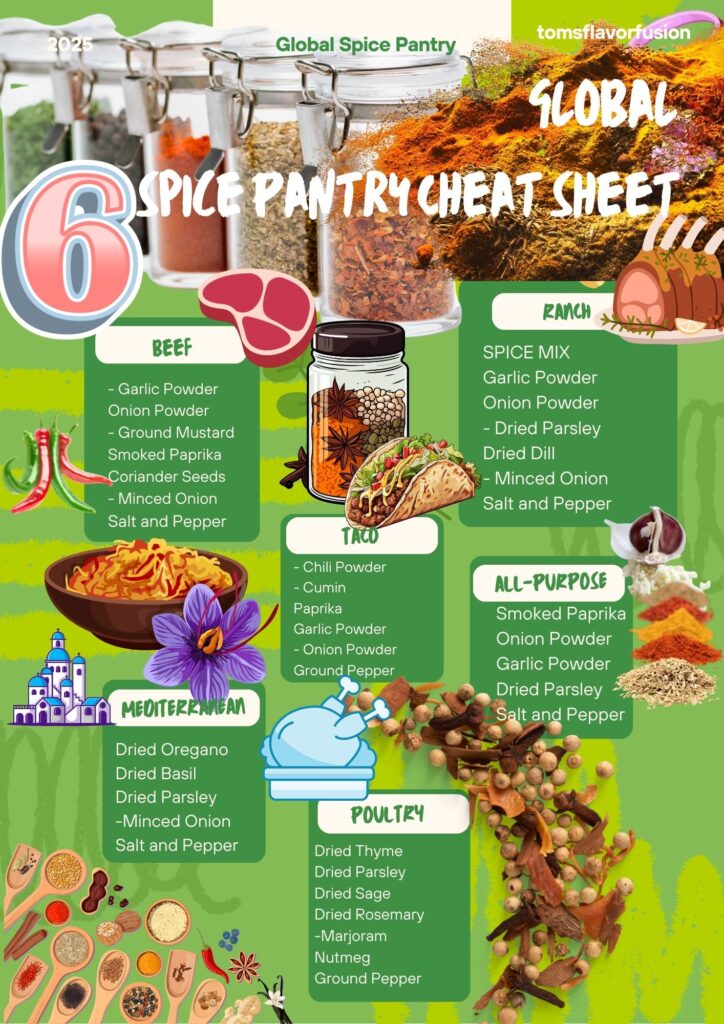We use affiliate links. If you purchase something using one of these links, we may receive compensation or commission.
Introduction
Spices are the heart and soul of global cuisine, transforming ordinary dishes into extraordinary culinary experiences. Whether you’re cooking a traditional dish or experimenting with new flavors, a well-stocked spice pantry is essential. This guide will help you navigate the world of spices, understand their unique characteristics, and use them to enhance your cooking.
Powered By EmbedPress
The Spice Categories
Understanding the different categories of spices is crucial for any aspiring chef. Here are the primary categories highlighted in the infographic:
Herbs
Basil: Sweet and slightly peppery, a staple in Mediterranean cooking.
Cilantro: Fresh and citrusy, commonly used in Mexican and Asian cuisine.
Oregano: Earthy and slightly bitter, perfect for Mediterranean dishes.
Seeds
Mustard Seeds: Ranges from mild to spicy, often used in pickling and Indian cuisine.
Cumin: Earthy and warm, essential in many global dishes.
Fennel Seeds: Sweet and slightly licorice-flavored, used in baking and savory dishes.
Barks and Stems
Cinnamon: Sweet and warming, used in both sweet and savory dishes.
Cassia: Similar to cinnamon but stronger, often used in Asian cooking.
Chilies and Peppers
Chipotle: Smoked jalapeños, adds a rich, smoky flavor to salsas and sauces.
Paprika: Sweet and smoky, ideal for Hungarian dishes.
Cayenne Pepper: Provides heat and spice, suitable for various spicy dishes.
Blends
Cajun Seasoning: A mix of spices perfect for adding a spicy kick to dishes.
Herbes de Provence: A fragrant blend of herbs used in French cuisine.
Garam Masala: A warm and aromatic blend used in Indian cooking.
Spice Flavor Profiles and Comparisons
Understanding the flavor profiles and best uses of spices can significantly enhance your culinary creations. Here’s a quick comparison of some popular spices:
Cinnamon vs. Cassia:
Cinnamon: Sweet, used in both sweet and savory dishes.
Cassia: Stronger flavor, commonly used in Asian cooking.
Chipotle vs. Cayenne Pepper:
Chipotle: Smoky, great for salsas and sauces.
Cayenne Pepper: Hot, used to add heat to various dishes.
Techniques for Maximizing Spice Potential
To get the most out of your spices, it’s important to use them correctly:
Toasting: Enhances the flavor of whole spices by dry-roasting them in a skillet before grinding.
Pairing: Experiment with different spice combinations to discover new flavor profiles.
Storage: Keep spices fresh by storing them in airtight containers away from light and heat.
Conclusion
Exploring the world of spices can elevate your cooking to new heights. By understanding the unique characteristics and best uses of different spices, you can create dishes that are bursting with flavor. So, embark on this culinary journey, experiment with spices from around the world, and let your taste buds be your guide. Happy cooking!


